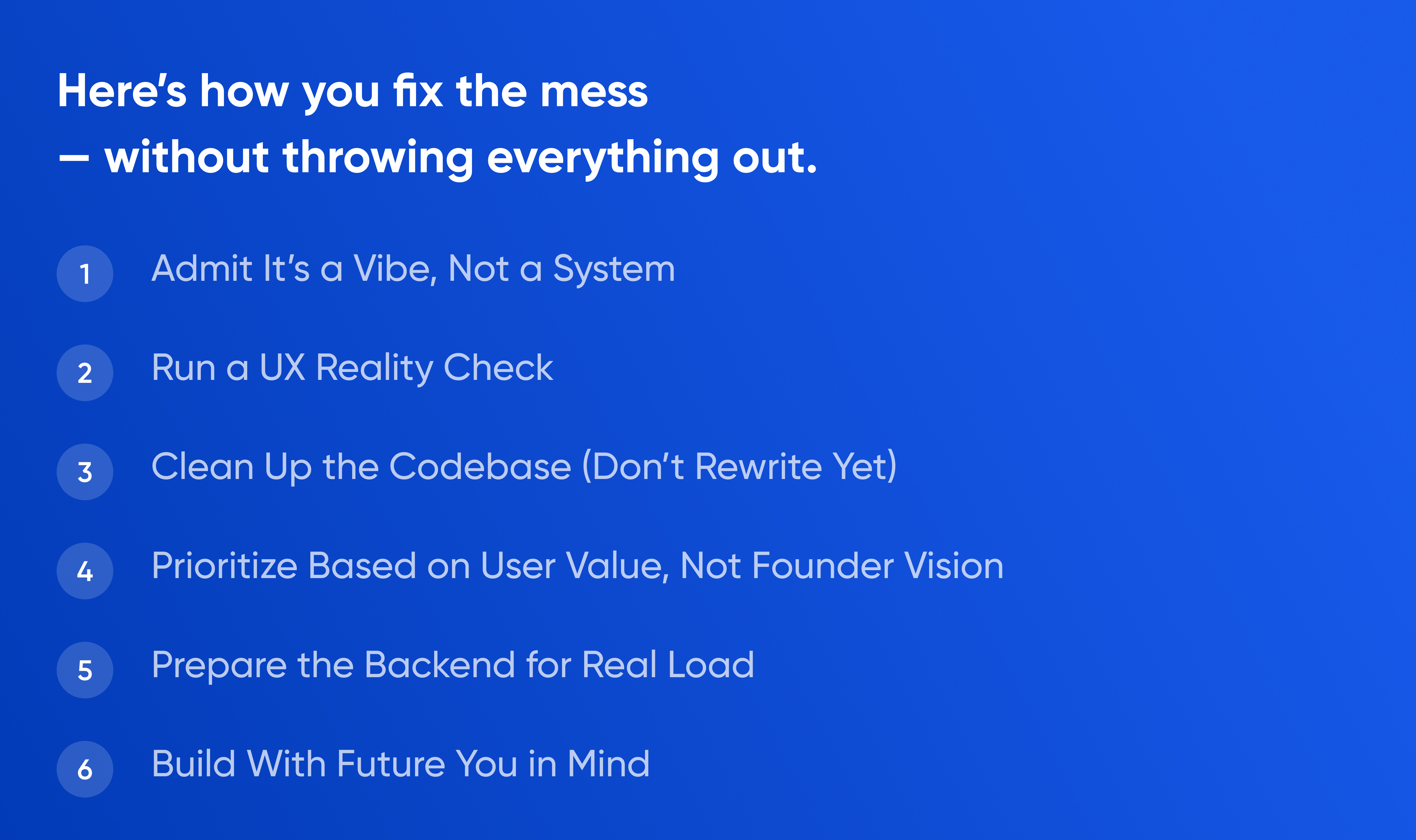Every startup founder knows the temptation: get the MVP live as fast as possible. Maybe you had a late-night idea, spun up a few screens in Figma, copied some code snippets from GitHub, and stitched together a React Native app that kinda-sorta worked. It looked decent, got the job done, and even landed a few users. Mission accomplished — until it wasn’t.
Welcome to the world of vibe-coded apps: products held together with duct tape and good intentions. These apps look great on demo day but start falling apart under real user pressure. They’ve got charming but inconsistent UI, features built on assumptions, fragile backends, and zero scalability. At best, they’re a vibe. At worst, they’re a ticking time bomb.
If this sounds familiar, you’re not alone. At Movadex, we’ve helped dozens of founders rescue vibe-coded MVPs and turn them into scalable, fundable, lovable products. Here’s how you fix the mess — without throwing everything out.

Step 1: Admit It’s a Vibe, Not a System
The first step is honesty. Your current app might be running, but it’s not ready for scale — and that’s okay. Vibe-coded MVPs are normal in early-stage tech. The problem isn’t that you hacked something together; it’s pretending it’s a finished product.
Take a step back and ask: can new developers onboard easily? Can you push features without breaking others? Can you identify where user drop-off happens? If the answer is no, it’s time to audit your foundation.
Step 2: Run a UX Reality Check
Many vibe-coded apps are designed by feel. Buttons float where they “look good.” Interactions happen because “it made sense at the time.” There’s no hierarchy, no consistency, and often, no flow.
Start by running usability sessions. Watch five real users try to complete common tasks. Don’t help them. Don’t explain. Just watch. You’ll see where your assumptions broke. You’ll see the pain points. And you’ll finally understand that your design isn’t intuitive — it’s just familiar to you.
Fixing the UX doesn’t mean redesigning everything. It means creating a structured experience:
-
Define primary actions per screen
-
Create consistent navigation patterns
-
Use spacing, color, and typography systematically
If you don’t already have a design system, build one. It’ll save hours later.
Step 3: Clean Up the Codebase (Don’t Rewrite Yet)
Vibe-coded apps usually have bloated, untested, and often unreadable codebases. But before you burn it all down and start from scratch, pause. Total rewrites are expensive, risky, and often unnecessary.
Instead, begin with a cleanup sprint. Focus on:
-
Removing dead code and abandoned features
-
Splitting massive files into logical components or services
-
Adding basic error handling and fallback states
-
Writing tests for the most fragile or business-critical paths
Introduce version control if you haven’t already. Set up branches. Use PRs. Document at least the top-level architecture. These small steps transform chaos into structure without halting progress.
Step 4: Prioritize Based on User Value, Not Founder Vision
One of the biggest traps in vibe-coded products is building what you think is cool — instead of what users actually need. You end up with five niche features and a broken login flow.
Look at the data. What features do users touch most? Where do they bounce? What bugs come up repeatedly? Identify the core user journey — not the future roadmap.
Focus your next sprint on:
-
Fixing the top 3 usability issues
-
Making the first-use experience flawless
-
Strengthening the most-used features
Defer the cool ideas. Ship the useful ones.
Step 5: Prepare the Backend for Real Load
That Firebase setup you launched in a weekend? It might be great for prototyping — but probably isn’t ready for 1,000+ users.
Audit your backend:
-
Are you writing to the database efficiently?
-
Is data being validated and sanitized?
-
Do you have proper auth and user roles?
-
What happens when 50 users try to do the same thing at once?
Start implementing proper environments (dev, staging, prod), basic logging, and monitoring. If your backend is on a platform like Supabase or Firebase, consider how you’ll migrate or modularize if you scale.
Step 6: Build With Future You in Mind
Your vibe-coded app got you here. But future-you — the one pitching investors, onboarding enterprise clients, or scaling to 100K MAUs — needs more.
Create a technical roadmap. Define when and how you’ll:
-
Implement CI/CD
-
Modularize your front-end architecture
-
Introduce analytics events
-
Integrate A/B testing
Don’t build it all now. Just know the path. Make today's decisions with tomorrow’s growth in mind.
Final Thought: Vibes Got You Started — Now It’s Time for Substance
There’s no shame in shipping fast. In fact, it’s a badge of honor. Most great startups begin as barely functional vibes — raw prototypes that prove there’s a need.
But scale is a different game. The messy code, inconsistent UI, and fragile infrastructure that helped you launch will hold you back from growing. Fixing a vibe-coded app isn’t about slowing down. It’s about creating a solid enough foundation that you can speed up without breaking everything.
At Movadex, we specialize in this transformation. We help founders stabilize their vision, productize their MVPs, and prepare for real traction. If you’re sitting on a vibe-coded app that’s not quite ready for the spotlight — let’s turn it into something your users will trust, your team can build on, and your investors will get behind.




